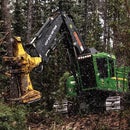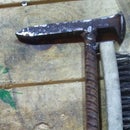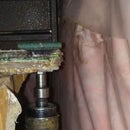Introduction: Broken Welder Experiment - Part 1
If your like me and you like welding and fabricating but don't have much money, the range of welding you can do is limited. I often find that with 110 volt flux core welders, they are built so poorly that the thickness of metal that may be welded is very poor. I bought a used 110 volt flux core welder and found it had several flaws:
- The breaker pops frequently because most 110 volt outlets don't have a 20 or 30 amp breaker and this machine is not a 220 volt machine
- The machine does not output enough current to effectively weld metals (80 amps)
- Flux core wire does not feed through the torch (torch liner is kinked)
With these issues and especially the last one, this machine does not function well as a wire feed welder. Since DIY welders are a fad in the maker community, I wondered if I could "Renovate" a broken flux core welder into a 220 volt welder.
Step 1: Safety
I am not responsible for any accidents or injuries incurred while attempting this project. I am also not responsible for any damage to your welder or any property if you attempt this death wish.... I mean welder! Always have a thorough understanding of your welder's electronics and don't do anything which might break the machine or put your life in danger. Arc flash can seriously screw up your eyes and welding gets very hot so wear a proper welding helmet, not the flimsy hand held shields that commonly come with cheap welders. Now would be a good time to write your will before you start the project so if anything goes wrong, your all set.
Update:
I am also going to warn you this machine didn't weld too well and I wouldn't recommend spending a dime on any materials. This project was an experiment and it turns out you are usually better buying a welder then trying to hack one. I ended up saving some money and purchasing a smaller DC stick welder that runs on 120vac and it costs less than double what I payed for the flux core welder. That machine welds far better than my homemade one. I learned I didn't have the skills to build a welder from a broken one, and most people would do better by saving money and buying a welder instead of trying to hack one.
Step 2: Parts
There are many ways of building a welding machine. The machine built here uses a transformer to step down the input voltage to a safer output voltage. Welders like this are far easier to work on because they tend to have fewer microelectronics and circuit boards than other welders. If your machine is an inverter welder this wont work. I strongly advise consulting the schematic of your machine before attempting to build a project like this, mine is the Harbor Freight "MIG" 100 110 volt welder. This could screw up your machine and cause expensive damage if you perform this on the wrong unit.
Parts needed will include:
- Broken "MIG" welder
- Plugs
- Large spool of Wire
- Solder
- Hot glue
Step 3: Gutting Your Welder
Firstly, check and then double check and then triple check that your welder is unplugged. Even if you like spiked up hair, your heart won't. I stripped almost every component out except the transformer of the welder. Because the torch is kinked, the wire feed mechanism is useless, we are going to turn this into a stick welder instead so the transformer, some switches and few other parts are only needed.
Step 4: Rewiring
I re-wired the machine to this schematic. You can add more components like a relay and dimmer switch to control the current better or diodes and capacitors to smooth the current. That will increase the cost of the build which put it out of my scope. Be sure to properly ground the transformer core and welding box to reduce the risk of electrocution and insulate the components as well as you can for caution. I would also omit the Min/Max switch in the schematic, It is wired into the PCB of the flux core welder and would be too difficult to install.
In part 2, I will attempt to weld with it and If that doesn't work, I will re-assemble the welder to its original design and figure something else to do with it. This is why I strongly advise you to not follow this. This is an experiment and I was writing a procedure.











